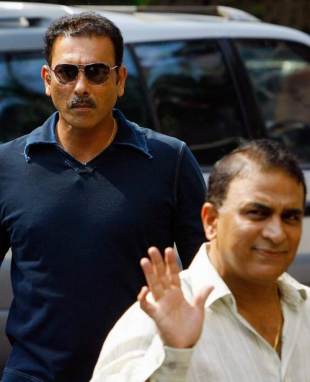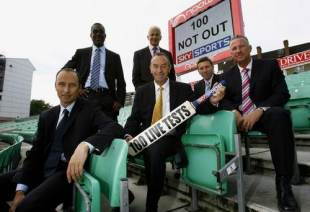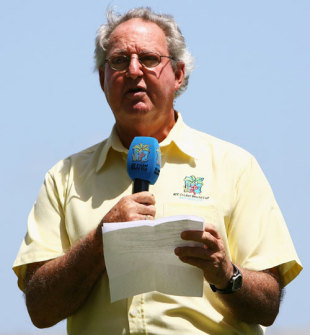Sold out
Just when and how was cricket commentary replaced by sales pitches and relentless hype?
Osman Samiuddin
10-Jun-2008
|
|

|
What, someone joked during the IPL, is the difference between those dancing by the boundary downstairs and those in the commentary box upstairs? Only that those downstairs have nicer curves.
This is what it had come to. The brief for the men in the box was narrow - to make sure only one message got out: come what may, the IPL was God, Lalit Modi was Moses, and there wasn't a rest of it. To speak was to hype, but only if it came with the right sponsor. Each six was a "DLF maximum", each critical point in the game a "Citi moment of success". Ravi Shastri, Arun Lal, Ramiz Raja, Sunil Gavaskar and the rest didn't call matches, they sold brands, blindly promoting the IPL (and anything else that came their way).
This was commentary as PR, a sales pitch from battered, desperate salesmen searching for one last fool; commentary reduced to the sycophantic, fawning babble political spin-meisters and brand ambassadors are paid for. If ever commentary was measured, that heard during the IPL would rank as the nadir in cricket's broadcast history.
How did it come to this, particularly in the subcontinent, where radio commentary was once so revered and vital, where early commentators were as much stars as those they spoke of? Omar Kureishi, Bobby Talyarkhan, Jamshed Marker, Berry Sarbadhikari: these were men who didn't just narrate the day's play, they were men who spread the early gospel. For their successors to be reduced to such buttering up isn't just a decline, it is like the fall of a civilisation.
What Packer wrought
They were men of a kind we may never see again. Without changing the sport too much, Kerry Packer changed the game completely. Arguably as significant as the pay hikes, the coloured clothing, the lights and the glam was the way Packer's Channel 9 changed how the story of each match was told. "Channel 9 brought to its coverage the idea of superimposing a specific vision on events," says Gideon Haigh, the cricket historian and writer. "Before World Series Cricket the action dictated the coverage. The cameras were static and distant; replays were scarce, and seldom shown more than once. WSC introduced the idea of using the characters, the stories, their statistics and replay technology, to create a master narrative."
They were men of a kind we may never see again. Without changing the sport too much, Kerry Packer changed the game completely. Arguably as significant as the pay hikes, the coloured clothing, the lights and the glam was the way Packer's Channel 9 changed how the story of each match was told. "Channel 9 brought to its coverage the idea of superimposing a specific vision on events," says Gideon Haigh, the cricket historian and writer. "Before World Series Cricket the action dictated the coverage. The cameras were static and distant; replays were scarce, and seldom shown more than once. WSC introduced the idea of using the characters, the stories, their statistics and replay technology, to create a master narrative."
This new, grand theatre required suitably grand narrators: the revolution, after all, had to be hyped. Ex-players had forayed into broadcasting before this. The BBC had the ever-smooth Richie Benaud early, as well as Jim Laker and Fred Trueman. ABC TV had Keith Miller and Frank Tyson, and even in the subcontinent, Vijay Merchant and Hanif Mohammad were on radio.
| Gradually it's been realised that the media runs cricket, that cricket owes everything to its electronic availability. The media now fancy they are entitled to be their own spectacle, to draw attention to their presence Gideon Haigh | |||
But Channel 9 opened the floodgates. Tony Greig was the hypemaster, ably supported by Bill Lawry, as excitable in the box as dour as he was on the field. Benaud was the masterstroke, giving the whole thing a quiet, cream-suited credibility. The authoritative and abrasive Ian Chappell joined the team soon after WSC ended and a template was set. The world soon followed.
"TV commentators have become much more 'in your face' post-Kerry Packer," says one of the few current non-playing voices, Christopher Martin-Jenkins. "Hitherto on the BBC, people like Brian Johnston and Peter West had essentially been heard and not seen. Tony Greig drove the original trend for TV commentators to have the kind of banter familiar to radio listeners but originally eschewed by, for example, Richie Benaud, who was brought up to believe that you should speak only if you could add to the picture."
The very roles changed. Where once the ex-player had been the summariser, the expert or the "colour" man, he now became the commentator, the main voice. Non-playing voices were nudged out, ex-players brought in. It was obvious why, for the big sell was on.
The changing relationship between the broadcast media and sport, suggests Haigh, spurred the process on. "When radio and TV began covering cricket, it was with a sense of privilege and deference. They were honoured guests in the house of sport and remained low-key, polite. Gradually it's been realised that the media runs cricket, that cricket owes everything to its electronic availability. The media now fancy they are entitled to be their own spectacle, to draw attention to their presence rather than remain silent witnesses. The focus comes to fall on 'personalities', on big names, on creating a kind of sideshow.
"There was no place for them [broadcasters without playing backgrounds] amid the hyperbole and histrionics of this new gladiatorial forum. The commentator in commercial media is selling the product. The commentator acts like a celebrity endorsement. When Sunil Gavaskar says a cover-drive is magnificent, it is like Sachin [Tendulkar] saying that Pepsi is refreshing."
|
|

|
With the proliferation of ex-players, naturally perhaps, objective depiction also took the hint, packed up and left, taking with it impartiality. Guest ex-players invited to cover overseas tours were experts but also de facto cheerleaders, providing not only insight for the home panel and listeners but a national balance.
Men such as Navjot Sidhu, his book of home-strewn Punjabi and English proverbs ready, arrived. Boisterous but utterly manufactured, Sidhu was baldly, unapologetically nationalistic, an Indian supporter first, commentator second. His stint as commentator was short-lived, but he lived on as an immensely popular media factotum, judging, analysing, expertising and anything else.
A landmark of sorts for this commentary-box jingoism was reached during the last Australia-India series. Into that on-field cyclone of pride, honour, chest-beating, flag-waving and cultural clashes jumped the two commentary teams from Channel 9 and ESPN-Star. Suddenly we were watching two different games, depending on which broadcaster you chose, Chappelli the only one straddling the divide.
"I suspect that commentators and summarisers have become less objective and this can only be because there are so many ex-players involved," says Martin-Jenkins. "It is certainly the commentator's duty, and arguably the summariser's too, to be fair and 'above the battle'." No longer.
An Asian affliction
The brunt of it has been felt in the subcontinent. Outside, by and large, the trend has hit at least as much as it has missed. Michael Atherton and Nasser Hussain are fine, considered finds for Sky. Michael Holding's voice remains as smooth as his run-up was, and his insights aren't bad either. Ian Healy and Mark Taylor aren't quite Lawry and Greig but they'll do.
The brunt of it has been felt in the subcontinent. Outside, by and large, the trend has hit at least as much as it has missed. Michael Atherton and Nasser Hussain are fine, considered finds for Sky. Michael Holding's voice remains as smooth as his run-up was, and his insights aren't bad either. Ian Healy and Mark Taylor aren't quite Lawry and Greig but they'll do.
In contrast, only a few names stand out in India and Pakistan: Sanjay Manjrekar commands respect and ears, and before their IPL stints, Ramiz, Shastri and Gavaskar did too. Beyond them there isn't much.
Pakistan's home ODI series against Zimbabwe in January missed the radar of most, but it didn't deserve the gut-churning commentary it got from a clutch of ex-Pakistan internationals and a random Zimbabwean (who asked Zaheer Abbas on air who Kerry Packer was). In India the commentators appear to be BCCI employees, and if their English is a little better than those of their neighbours across the border, their analysis plumbs the same depths.
"Commentary standards on the subcontinent are dipping," says one experienced broadcaster, "and the biggest reason is the insistence on former cricketers who aren't articulate enough or willing to learn the language of television.
"There is tremendous arrogance in the cricket system which prevents learning, so people believe it is their right to find a place in the commentary box straight after they take their pads off. In Australia and England they don't have the same star system and people have to earn their spot. There is no comparison between levels of professionalism there and here."
| Soon mere stagnation might be the least of our concerns. Soon commentators will be selling in between deliveries. Soon the ad break might be a break from one long ad break | |||
This, it seems, is the key. It is easy to dismiss this deterioration as a thing only of language - that those in the subcontinent are not as proficient with English. This overlooks that Hindi and Urdu commentary is equally gormless, but importantly, it deflects attention from the biggest failing of today's breed. Not that Charu Sharma, a senior presenter and broadcaster, has missed it.
"Commentary is something you have to work on," he says, "and you need to keep working on it, just like when they were cricketers. Maybe they don't understand that this is a serious job. Stagnation is there: hear them once, hear them forever. There is no reinvention."
Few who have heard of the shot "that went like a tracer bullet" or some batsman's "lazy elegance" over and over and over and over again, and then once more, will argue with Sharma's assessment.
The pitch
Soon mere stagnation might be the least of our concerns. Soon commentators will be selling in between deliveries. Soon the ad break might be a break from one long ad break. The IPL, some worry, is just the start of it.
Soon mere stagnation might be the least of our concerns. Soon commentators will be selling in between deliveries. Soon the ad break might be a break from one long ad break. The IPL, some worry, is just the start of it.
Not that Lalit Modi and his suits can take credit for this. Plugs during commentary have been around. In Pakistan, Chisty Mujahid remembers pokes on his shoulder urging him to remind listeners that cricket was brought to them by makers of cancer sticks. Grudgingly, he says, listeners were reminded.
But as with so much in this tale, Channel 9 pushed it further. So Benaud and company, in between overs and breaks, began mumbling about some absolutely lovely cricketana, from signed bats to framed autographs to DVD collections. And they began pushing the network's other programming as well.
|
|

|
The IPL's commentators have trumped even Channel 9 and done it with, at worst, such glee, and at best such soulless automation, that fault has to be found with Sharma's contention that "every single commentator would be uncomfortable doing this". Sixes and "moments" are now branded. What odds wickets, fours and catches won't be soon? The day, the writer Rahul Bhattacharya noted recently, a batsman plays a "Toyota Front-Foot Drive against an Intel Faster One" mightn't be far.
Some broadcasters, like Sky, says Martin-Jenkins, remain resolutely above this bazaar, concentrating on cricket itself. But how long can anyone hold out? "What better way to sell something than through the game itself?" asks Sharma. "You don't even need to go to an ad break. It will happen more and more."
Even if it isn't inevitable, what will stand in its way? "Broadcasters are monopolists," says Haigh. "If you want to watch the cricket, you have to put up with the crap they serve as accompaniment. Like all monopolies, they become lazy, flaccid, self-satisfied. Wouldn't it be interesting if there was some red-blooded competition between commentary teams, to go with red-blooded competition on the field?" Viewers may have a say in the matter, though whether or not commentary is as relevant to them as it once was is unclear. That remains a discussion for another time.
***
It is noble, of course, that the game offers those who once served it an opportunity to make a living once their limbs are no longer up to it. Few other sports are as keen on getting ex-players into commentary. And when done well, there are benefits, for everyone loves the insight a top player can provide.
But the pendulum has now swung too far the way of ex-players - the balance of the articulate, witty voice offsetting the rough but insightful expert gone. The monster of Loch Ness might emerge before another Tony Cozier or Harsha Bhogle. Ex-players are there, as Haigh articulates, "to bless the action by their presence rather than to illuminate it."
It is sad, for as much as it is the players who make the game what it is, the men and women who tell their deeds are a vital part of the broader tapestry. Every sport needs a voice and cricket once had one of the richest. It is in danger of losing it.
Osman Samiuddin is Pakistan editor of Cricinfo